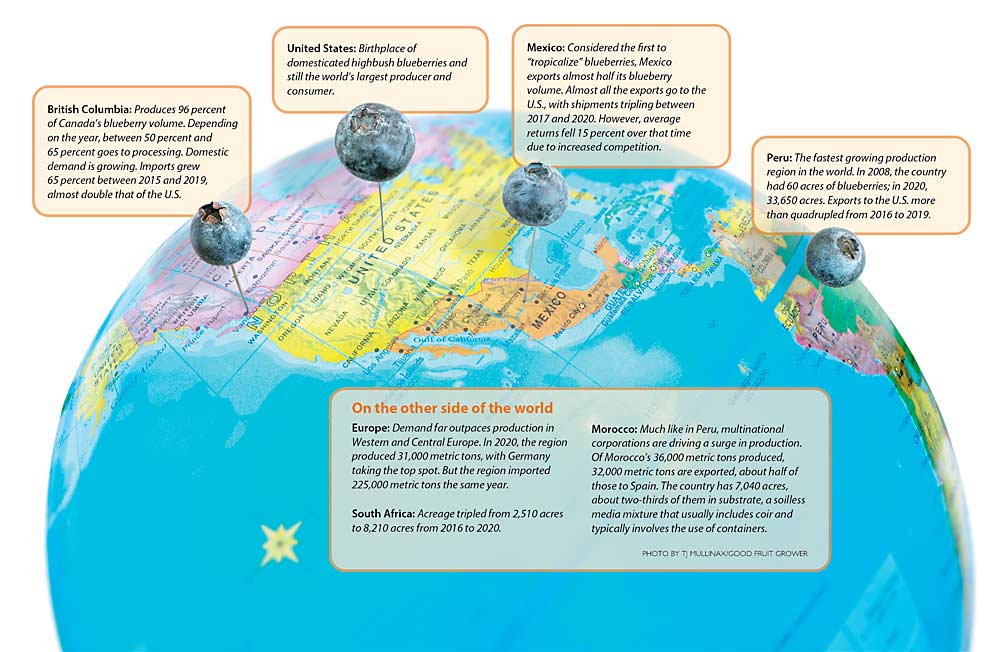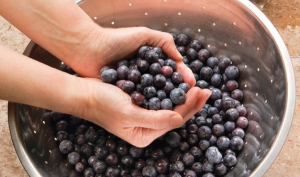The blueberry industry is trying to take over the world.
Faced with surging global production, blueberry marketers are looking for ways to make their fruit the “world’s favorite fruit.”
As the U.S. Highbush Blueberry Council’s five-year strategic marketing plan puts it: “The USHBC empowers the industry to make blueberries the world’s favorite fruit.”

The goal is more of a vision statement than clear target, said Kasey Cronquist, president of the Folsom, California, organization that collectively markets blueberries under a federal checkoff program.
“This is aspirational,” he said.
For one thing, measuring consumption is tougher than measuring production. There is also the difference between volume and dollar sales. Then, add in the fact that the Food and Agriculture Organization of the United Nations puts 2019 global blueberry production at a fraction of bananas, melons, apples, oranges, grapes and more (see “Who’s counting?” at the end of this story).
But shooting so high makes other goals more achievable, such as boosting demand, filling the market 52 weeks a year and improving quality through variety development, Cronquist said. The board approved the plan in October 2021, just as the required grower referendum to continue the assessment-funded program passed with a record-setting voter turnout by volume.
Here are a few more pragmatic aims from the document:
—Increase food service penetration from 24 percent to 35 percent by 2025.
—Increase retail household penetration from 49 percent to 59 percent.
—Boost food manufacturing ingredient use, which was 85 million pounds in 2019, to 150 million pounds. The USHBC contracts Mark Crowell of CuliNex, a Seattle food consulting company, to develop recipes for everything from blueberry kombucha to desserts.
—Double exports as a percent of production from 5 percent to 10 percent. The U.S. Department of Agriculture has doubled the blueberry group’s Market Access Program funding for 2022. Major markets of focus will include Japan, South Korea, China and Southeast Asia. Some of these markets just recently opened.
To measure some of these goals, the USHBC recently hired Joe Vargas as director of business intelligence, a new role responsible for developing data and insights. His job will be to help determine how well marketing efforts work, based on data from Nielsen ratings, Category Partners and other analytical services for the food industry. He also will organize a national platform of data collection and steer crop reporting and projections.
Variety development remains a critical point, and the industry is making headway, Cronquist said. Consider that grapes have had 1,000 years for variety work, but blueberries, comparatively, are just getting started, he said. “Just imagine what blueberries are going to taste like in 10 years.”
The group also is doubling down on nutrition messaging, part of the reason blueberries are so popular in the first place. The USHBC hired a full-time nutritionist last year.
One of the industry’s favorite metrics is the U.S. household penetration rate. Strawberries hover around 20 to 30 percentage points higher than blueberries on that scale. Some speakers at one of USHBC’s spring conferences project blueberries will catch up by 2034.
“While it’s lofty and audacious, I don’t think it’s out of the realm of possibility,” said Brian Bocock, vice president of product management for Naturipe Farms, on a May podcast hosted by Cronquist.
In fact, the overall “favorite” goal may not be that aspirational in terms of retail sales in the United States, blueberries’ largest market.
In 2021, U.S. apple retail sales were $3.96 billion, said Desmond O’Rourke, a global tree fruit market analyst from Pullman, Washington, citing data from IRI, a retail analytics company. Grapes and bananas also topped $3 billion. Blueberries fetched a total of $2.35 billion.
“There is no doubt that at the current rate of growth, blueberry dollar value can surpass apples in the next few years,” O’Rourke said.
Blueberries indeed chase apple-type levels, Cronquist said, but that projection assumes apple consumption remains relatively flat in the U.S., and blueberry increases continue.
Moreover, the marketing plan aims to keep blueberry demand high in the face of surging volume increases throughout the globe. Lofty goals are good for all growers, large and small, Cronquist said.
“It only benefits every-sized grower to have the vision of making blueberries the world’s favorite fruit,” Cronquist said.
Terri Weijohn buys that argument.
Weijohn, who owns Blueberry Hill in Wapato, Washington, appreciates the marketing clout and ambition because it gets the attention of customers.
“Consumer perception impacts sales,” she said.
She doesn’t mind the “symbiotic” relationship between different growing regions, as the industry fills the fresh market year-round. Marketing on a global scale makes that possible.
The wholesale portion of her family’s business has grown by 30 to 50 percent over the past five years, she said.
And she sees similarities between the tactics called for in the marketing plan and those of her family’s farm, just on a vastly different scale.
Take pitching blueberries as a food product ingredient, she said. About 10 years ago, her family began making a blueberry-based frozen dessert, to use up extra berries, and sold it at their farm stand. In 2018, they started packaging it commercially under the name Sorbatto Blue Cream, and they now sell it in Whole Foods grocery stores throughout the Northwest.
“It’s important to have a strategy for when prices are good, and it’s important to have a strategy for when they are going down,” she said. •
—by Ross Courtney
Who’s counting?
Declaring a world’s favorite fruit is harder than you’d think.
The U.S. blueberry industry has a strategic plan to make its fruit the “world’s favorite fruit.” They admittedly have a long way to go.
But the title would be elusive anyway. Declaring a winner of the “World’s Favorite Fruit” title involves measuring consumption, which is much harder to track than production and acreage. And even production rankings vary based on whom you ask and how they define “fruit.”
For example, WorldAtlas calls tomatoes the most harvested fruit in the world, followed by bananas, watermelons, apples and oranges. As the seed-producing part of a plant, tomatoes are indeed fruit, but other rankings list them as vegetables. Besides, tomatoes have an advantage with ketchup and marinara sauce.
The United Nations Food and Agriculture Organization lists bananas, watermelons, apples, oranges and grapes as the Top 5 in 2019. Tomatoes are in the vegetable category but would be second among fruit by FAO figures. (Go to: fao.org/3/cb4477en/online/cb4477en.html#chapter-2_1.)
Guinness World Records calls bananas the world’s most consumed fruit, as well as the fourth most important food staple in the world. But the folks at Guinness include plantains in their math. Other lists separate those. (Go to: guinnessworldrecords.com/world-records/74279-most-popular-fruit.)
The U.S. Department of Agriculture ranks fruit consumption, but only for the United States. In 2019, the Top 7 were apples, oranges, bananas, grapes, watermelons, strawberries and pineapples. That includes fresh and all forms of processed fruit. Bananas led the way in fresh consumption. (Go to: ers.usda.gov/data-products/chart-gallery/gallery/chart-detail/?chartId=58322.)
The Packer surveyed U.S. customers and came up with a list of favorite fruits. Bananas, strawberries, apples and grapes were Nos. 1–4, respectively. Blueberries came in seventh. (Go to: freshproduce.com/resources/consumer-trends/top-20.)•
—by Ross Courtney









Do tropical blueberries taste different from those grown in temperate climates?
Hey there. Thanks for such a good question. I asked Lisa Wasko DeVetter, WSU’s blueberry extension specialist from Mt. Vernon. Here’s her answer, which is probably a little more than you bargained for:
“There are many species that we commonly call “blueberries”. In the Pacific Northwest and Michigan, northern highbush blueberry (Vaccinium corymbosum) is predominant. In Maine and Nova Scotia is lowbush blueberry (Vaccinium angustifolium). Lowbush blueberry is often marketed as “wild” blueberries. There is also rabbiteye blueberries (Vaccinium virgatum) in parts of the southeast of North America. In more sub-tropical to tropical regions is the southern highbush blueberry, which is a complex, interspecific hybrid of Vaccinium corymbosum plus other species. On the basis of genetics, species and cultivated varieties (i.e., cultivars) will have differences in berry quality including the predisposition for certain sizes, texture, and flavor. The environment can also interact and impact quality within a cultivated variety. In short, there are a lot of complex, interacting factors that influence berry quality and ultimate taste!”
Haha well I appreciate the thorough response!